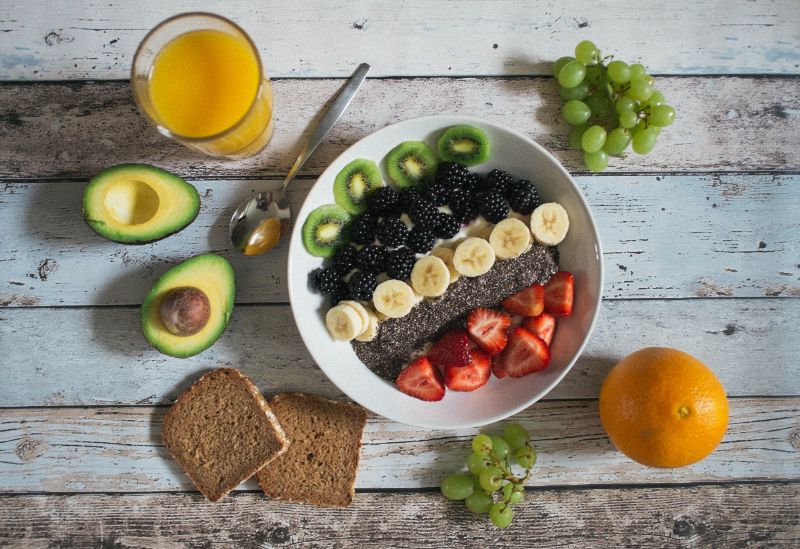Preparing for a race traditionally involves a pasta party. We show you the effects this has on your body and the alternatives for optimal nutrition before and during a race.
Goals of race nutrition
- To arrive at the start with optimally filled glycogen depots in the muscles and liver.
- To avoid a drop in blood glucose levels under stress.
We will show you in two steps how energy can first be optimally stored and then efficiently converted.
I. Energy storage
Carboloading and supercompensation

Endurance performances are energy performances. The amount of energy available for a competition is largely determined by nutrition, as this influences both the quality and the quantity of the “fuel” supplied. Carbohydrates are the main essential source of energy in the diet and are stored in the body in the form of glycogen.
Glycogen is the highest-quality fuel available to humans for endurance performance, but the amount that can be stored is limited. For decades, endurance athletes have therefore sought to increase the size of their glycogen stores through training and diet. A procedure known as “carboloading” originated in Scandinavia and is used to specifically increase the body’s carbohydrate reserves before a competition.
Traditional carboloading begins with exhaustive training one week before the competition. Athletes then continue to train and eat a low-carbohydrate diet with the aim of completely emptying the glycogen stores in the muscles. Three days before the competition, the athletes then take a break and start a high-carbohydrate diet to achieve supercompensation – i.e. to fill the carbohydrate stores beyond the initial level.
This procedure has many disadvantages:
- The long training session needed to completely empty the stores, which already falls into a phase of low carbohydrate intake, cannot be contested at competition speed. This doesn’t ensure that the muscle fibres are sufficiently selectively emptied.
- Side effects such as nervous fatigue, hormonal imbalances and damaged muscle cells can jeopardise racing success.
This has led to the understanding that supercompensation of glycogen reserves and optimal performance can be achieved even if the diet is restricted to the high-carbohydrate phase of the diet.
We now know that endurance training most strongly stimulates muscle glycogen synthesis. Endurance training increases the activity of glycogen synthesis and the enzymes responsible for glycogen storage. But timing is just as important! For certain adaptation processes of the body, there are narrow time windows in the metabolism that have to be taken into account.
The narrow time window
Starchy foods and legumes (major sources of carbohydrate in our diet) can be stored in greater amounts as muscle glycogen after stores have been significantly depleted previously. In the hours following a long or intense workout that was detrimental to muscle glycogen reserves, there is an optimal window of 4-6 hours to replenish the depots. When the glycogen reserves are actually depleted, the muscle cells recharge with glycogen much more easily.
The solution: 2PEAK Loading
Let’s say the race is on Sunday (road race, 10km run, marathon, triathlon or other endurance event). Here is the procedure:
- Wednesday: A long workout (one to three or more hours, depending on the chosen competition sport), with 1-3 intervals at competition speed. Avoid starchy foods (carbohydrates) the night before to maximise depletion. Once you are back from training, have a recovery drink. This prepares the absorption of glycogen while the muscle cells are rehydrated. Recovery drinks can be special products or simply half a litre of apple juice. Then you should eat your first solid food one to two hours* after training. This should be rich in carbohydrates and as alkaline as possible (to bind acids), for example dried fruit or bananas. The following meal should be dominated by carbohydrates. Potatoes (very alkaline) and pulses (rich in fibre and minerals) are preferable.
- Thursday, Friday and Saturday should be used to relax – in every sense. Light, carbohydrate-rich meals should be eaten after each, even light, restorative training sessions. All meals should be high in carbohydrates. High-fibre foods should be largely avoided during these three days to prevent any digestive difficulties.
Note: Large amounts of pasta on Saturday evening (pasta party) are counterproductive for performance the next day! This is especially true for very well trained athletes who have exceptional and specific body adaptations. Because the actual “pasta party” has been going on since Wednesday! On Saturday evening it is too late for the dance! Explanation: Without an exhaustive workout that day, you would only store a small amount of the starchy food or other carbohydrates in the form of glycogen. The excess carbohydrates would be transformed into fats and stored, which would put a lot of strain on the digestive system.
In addition, because each gram of carbohydrate also binds 2.7 grams of water, the pressure in the venous and lymphatic systems would be disrupted and with it the entire cell movement in the body. The next day you would be at the starting line with a few grams of extra fat, plus one to two kilos of extra weight in the form of water stored in the interstitial tissues as a result of the rapid change in pressure in the lymphatic system. Cyclists know the phenomenon when they wake up in the morning with the feeling of having two “pads” instead of legs.
*It takes some time before enough blood is available in the digestive system again after an effort. Wait at least an hour before eating a carbohydrate meal after a long/intense effort. If you finish a hard workout with a 15-minute cool-down period, you can start eating 45 minutes after the end of the workout.
The last meal before the race

Athletes know that they should allow a minimum time between their last meal and the start of a race. This time varies from individual to individual and is particularly dependent on the level of exertion. It also has to do with the intensity with which the race begins and continues.
For some of us, nothing seems to fit in the stomach on race morning. The stomach is closed, sealed and doesn’t want to digest anything. For others, the stomach feels totally empty two hours after breakfast. If the start is very early, it may be necessary to choose very specific food, depending on which group you belong to. For those with a closed stomach, liquid food is the best solution. For the others, a starchy meal with a low glycaemic index is best – with a slight addition of protein. Three to four hours before the start is the best time.
If the race starts off emphatically quiet or the competition/event is not run at a high level, a normal breakfast can be taken. If the race is not until the evening, normal meals can be eaten during the day and a pre-competition meal can be taken three to four hours before the start (see below). After the last solid meal before the start, it is recommended to take a small mouthful of a pre-competition drink every 20 minutes or so.
This approach allows anyone in any situation to start with a light stomach and an ideal liver glycogen level (which ensures blood glucose levels are maintained).
The last meal: two solutions
1) A traditional sports meal: cereals such as millet, wheat (better: spelt) or cooked amaranth in soy milk, a rice or other non-dairy drink, sweetened with fructose are perfect. Cereals can be prepared the day before and then eaten at room temperature.
2) A specific pre-competition drink
II. energy release
Avoid hunger pangs
The blood sugar level must be kept very constant. There is an important reason for this: glucose is the fuel for the nervous system, including the brain. This is also the reason why a lack of blood sugar leads to dizziness. Even a slight drop in blood glucose levels can cause the brain to shut down all “racing functions” and instead activate a safety system designed to protect the brain itself.
The goal of all food intake during the race is first and foremost to avoid a drop in blood sugar (decrease in blood sugar due to consumption of liver and muscle glycogen). This delays the degradation of muscle glycogen and also prevents a strong reduction of branched-chain amino acids (BCAA) in the blood.
A significant modification of these parameters automatically results in a reduced physical capacity and thus reduces the intensity that can be maintained during athletic activity. The ability to regenerate decreases. The well thought-out combination of pre-competition nutrition and energy drinks and/or gels contributes significantly to being able to perform optimally until the end of a race.
No bars during high exertion
During a race load, the digestive system is supplied with less blood. In addition, it must be taken into account that the amount of fluid that can pass through the stomach in a given time depends on the concentration of the food and minerals contained. To solve this equation, the pyhsiological peculiarities of digestion must be taken into account.
The stomach allows a liquid whose mineral concentration is lower than that of the blood to pass through its walls more easily. The difference in osmotic pressures is responsible for this. A drink that is to be absorbed under exertion must therefore be lower in concentration than the blood. But we also know that a minimum concentration of carbohydrates is necessary to maintain performance. It should be noted, however, that the retention time in the stomach also increases with the carbohydrate concentration. A slightly osmotic glucose solution (139 mmol/L) passes the stomach in 20 minutes whereas the same amount of liquid with a concentration of 834 mmol/L needs two hours!
After a large number of studies, we know that fructose of appreciable concentration is absorbed somewhat faster than glucose and maltodextrin. We also know that liquid food taken in regular small sips should not cause any problems with digestion – quite the opposite of solid food, which is very difficult to digest when exerting above 80 per cent of V02max. Bars, sandwiches and the like are taboo during high effort (ask your stomach)!
The solution: 2PEAK Fueling
Where do all these ideas lead us? The only solution is a sports drink with a subtle taste containing fructose, glucose and maltodextrin in a concentration between 40 and 80 grams per litre (depending on the temperature). The mineral concentration should be low (especially not too much sodium). Instead of a sports drink, a combination of gels and the appropriate amount of pure water can also be taken – which of course is not quite as easy to dose as a ready-mixed drink. But on long distances (marathons) gels are no alternative.
500 to 800 millilitres** of ready-made solution should be consumed per hour. That’s a mouthful every ten minutes. This amount of food may seem small, but it is still more than what athletes actually consume. At least, that was the result of a study among non-professional endurance athletes. The prerequisite is that you learn to eat regularly and actually eat the food you carry with you. Gels that you carry to the finish line don’t help at all! Eating properly during competition is a matter of practice and should be tried out and trained during harder training sessions.
**More water can of course be consumed in addition at any time, provided it is PURE water.